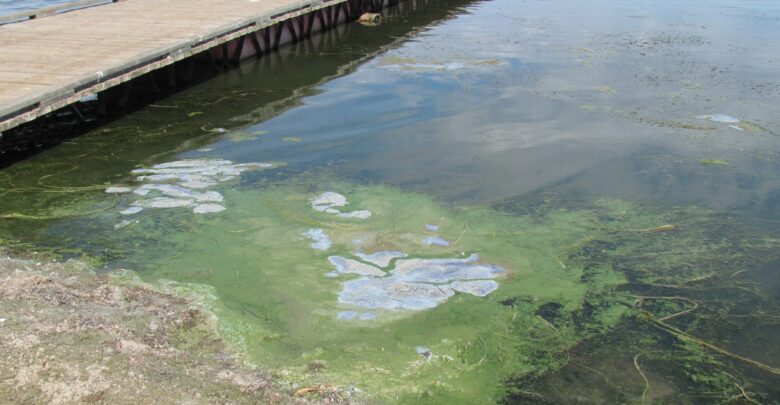 Environmental Public Health, Alberta Health Services
Environmental Public Health, Alberta Health ServicesAccording to a University of Alberta professor, the yearly blue-green algae blooms in Alberta lakes can be dangerous.
Rolf Vinebrooke, a professor in the department of biological sciences, is studying cyanobacteria, commonly known as blue-green algae. He has identified a surge of blue-green algae in Alberta lakes and warns recreational lake goers of the harmful effects it has on livestock, pets, and humans.
“Cyanobacteria can be considered to be microscopic plants. Because they’re essentially bacteria, they grow a lot faster into massive outbreaks, referred to officially as blooms,” Vinebrooke explained.
These blooms occur in environments with ideal levels of nutrients and warm temperatures, Vinebrooke added. Alberta has a “very fertile landscape,” making it prone to outbreaks.
“Blue-green algae have been around since the beginning of life on Earth. They’re very adaptive,” Vinebrooke says
According to Vinebrook, blue-green algae blooms tend to be problematic due to two major toxins they release — neurotoxins and hepatotoxins.
“[Neurotoxins] inhibit nerve impulses to travel across synaptic gaps and nerve tissue resulting in disorientation and difficulty with breathing. Hepatotoxins degrade liver tissue by causing cell and capillary ruptures,” Vinebrooke said.
Vinebrooke added that the other problem with blue-green algae blooms is their decomposition. Blooms are not edible for the majority of lake organisms. When temperatures start dropping, blooms use large amounts of oxygen to decompose.
“You can get lethally low levels of oxygen, causing other organisms not to have enough to survive. [This causes] fish kills, sometimes referred to as dead zones, in lakes.”
Vinebrooke said that there is a knowledge gap in understanding blue-green algae — researchers haven’t identified what causes them to release toxins.
“There’s a bunch of different competing hypotheses but there’s not much known about what exactly is the perfect set of conditions that makes them [release] toxins.”
Another knowledge gap is that there is no set strategy for getting rid of blue-green algae blooms, Vinebrooke said.
“Blue-green algae have been around since the beginning of life on Earth. They’re very adaptive. No matter what you throw at them, they will probably acclimate and stay around.”
Vinebrooke describes strategies used to control outbreaks in Alberta
A major nutrient that helps form blooms is phosphorus. As a strategy, people have been trying to control the amount of phosphorus that gets disposed in lakes. Vinebrooke thinks that this is not a long-term solution.
“Often it’s too late because people have been overdoing phosphorus fertilizer for quite a long time. Once the phosphorus is in the lake, it doesn’t just disappear. It gets internally recycled. [Blue-green algae] are living off the legacy effect.”
Vinebrooke added that chemical methods to address bloom growth are also used. In this case, chemicals that bind to phosphorus are thrown in a lake and the cyanobacteria can’t feed on the phosphorus anymore.
“It’s a million-dollar industry of throwing chemicals into lakes. A lot of people, including myself, are not particularly strong proponent[s] of that because, in turn, you’ve got a strange mixture of chemicals you wouldn’t find in a lake naturally.”
Lastly, bio-remediation is a strategy that is used in Europe and the United States but hasn’t yet been adopted in Canada. Bio-remediation involves increasing the number of organisms that can eat blue-green algae. However, Vinebrooke said that “the effect seems to wane over a few years.”
According to Vinebrooke, human actions such as landscape management can lead to a surge in blue-green algae. Landscape management can remove barriers like wetlands and marshes that typically catch nutrients. Without these barriers, blue-green algae have direct access to feed on the nutrients. He added that climate change is another factor.
“The blue-green algae that we are concerned about thrive under warmer temperatures which are happening more and more frequently.”
“The ultimate goal is to create a forecasting model like weather stations do, but only for lakes,” Vinebrooke says
Vinebrooke is currently in a research team that is using satellite imaging to study blue-green algae. Satellites capture images of lakes almost daily, allowing a more thorough understanding of blue-green algae change and growth.
The research team is hoping to generate a predictive model that uses satellite data to predict blue-green algae blooms. This could make an estimate of how serious a blue-green algae outbreak will be for a whole lake.
“The ultimate goal is to create a forecasting model like weather stations do, but only for lakes. This is to inform the public via an online format in real-time so they can plan their recreational use of different lakes.”




